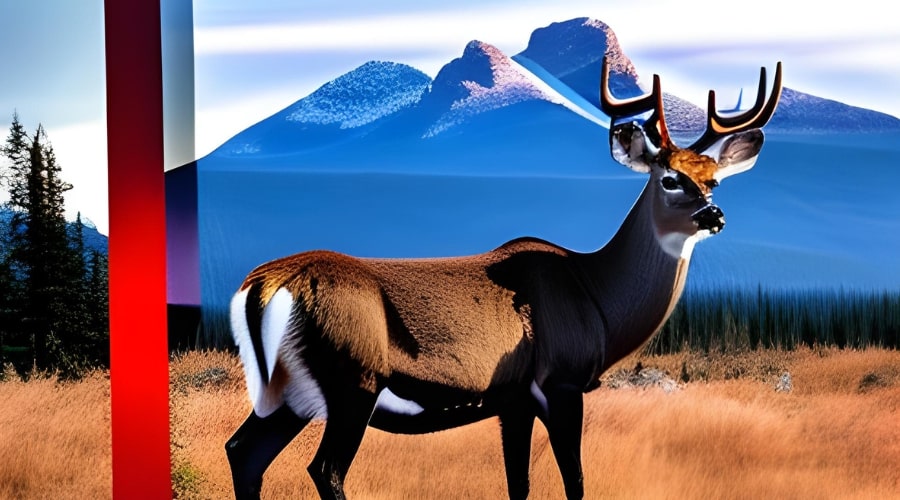Odocoileus deer, known as whitetail deer, is one of North America’s most popular game animals. These graceful creatures are found throughout the continent and adapted to living in diverse habitats. This article will explore Odocoileus deer’s habits, characteristics, and life cycle in detail.

Appearance
Whitetail deer are medium-sized deer with a distinctive white underside to their tail. They have a reddish-brown coat in the summer that turns grayish-brown in the winter. The males, also known as bucks, have antlers that they shed and regrow every year. The antlers can grow up to 10 points and are used for territorial fights during mating season.
Habitat
Odocoileus deer are found in various habitats, including forests, swamps, grasslands, and farmlands. They are adaptable and can survive in areas with a high human population. They are primarily found in North America, from Canada to Mexico.
Diet
Whitetail deer are herbivores and eat a wide variety of plants. Their diet includes leaves, twigs, fruits, and nuts. When food is scarce in the winter, they eat bark, buds, and even lichen. In areas where they coexist with humans, they eat crops such as soybeans, corn, and alfalfa.
Behavior
Whitetail deer are primarily nocturnal and are active during the night. They are social animals and live in groups called herds. The size of the herd depends on the habitat and food availability. During the breeding season, which occurs in the fall, males become more aggressive and will fight other males for the right to mate with the females.
Reproduction
Whitetail deer have a polygamous mating system, meaning one male mates with multiple females. The breeding season, known as the rut, lasts from late October to early December. The gestation period is approximately 200 days, and females typically give birth to one or two fawns in the late spring or early summer.
Life Cycle
Whitetail deer have a lifespan of about 6 to 14 years in the wild. They reach sexual maturity at about 1.5 years old. Fawns stay with their mothers for the first year of their life and then become independent. They increase; by the end of their first summer, they are about half the size of an adult deer.
Predators
Whitetail deer have many natural predators, including wolves, coyotes, bobcats, and cougars. They are hunted for meat and antlers in areas where they coexist with humans. However, deer overpopulation is a problem in some areas, and hunting is necessary to keep the population in check.
Conservation Status
Odocoileus deer are not considered endangered, but their populations have declined in some areas due to habitat loss and hunting. However, their people has increased in other regions due to conservation efforts and the decline of natural predators. It is essential to manage the deer population to prevent overgrazing and ecosystem damage.
FAQs:
What is the average size of a whitetail deer?
A whitetail deer’s average size varies depending on age and sex. On average, adult males weigh between 120-300 pounds, and females weigh between 90-200 pounds.
How long do antlers take to grow?
Antlers take about 4-5 months to grow, starting in the spring and ending in the late summer or early fall.
Are whitetail deer dangerous?
While whitetail deer are not typically aggressive toward humans, they can become aggressive if threatened or cornered. It is essential to keep a safe distance and never approach a deer.
Can whitetail deer swim?
Yes, whitetail deer are strong swimmers who can swim across water bodies, such as rivers or lakes, to escape predators or find food.
How fast can whitetail deer run?
Whitetail deer can run up to 40 miles per hour, making them very fast and agile.
What is the best time to hunt whitetail deer?
The best time to hunt whitetail deer is during the rut, which occurs in late October to early December when males are more active and visible.
How can I prevent deer from eating my garden plants?
Some ways to prevent deer from eating your garden plants include using deer-repellent sprays, fencing your garden, and planting deer-resistant plants.
Do whitetail deer have any predators besides humans?
Yes, whitetail deer have several natural predators, including wolves, coyotes, bobcats, and cougars.
How long do fawns stay with their mothers?
Fawns stay with their mothers for about a year until they are old enough to be independent and mate independently.
Conclusion
Odocoileus deer are fascinating animals that have adapted well to living in diverse habitats. Their unique appearance, diet, behavior, and life cycle make them essential to North America’s wildlife. It is crucial to balance conservation efforts and hunting to ensure their populations remain healthy and stable.





Leave a Reply